ARE CHACKRA REAL? , DO YOU BELIEVE IN CHACKRA READ AND BE ENLIGHTENED.
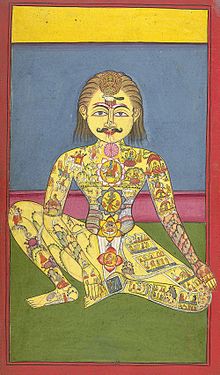
Sapta Chakra, an early 19th-century manuscript (above) illustrates the parts of the body connected to yoga.
Chakras (Sanskrit: चक्र, IAST: cakra, Pali: cakka, lit. wheel, circle), ar focal points within the refined body utilized in a spread of meditation techniques within the private traditions of Indian religions and utilized in new age drugs and scientific discipline.
The idea is found significantly within the Tantrik traditions of Hinduism, Buddhism and Jainism. they're treated as focal points, or psychic nodes within the refined body of the professional person. The idea of the cakras is Associate in Nursing integral a part of kundalini yoga, however not all systems of the cakras consider kundalini. These theories disagree between the Indian religions, with several private Buddhist texts mentioning four Chakras, whereas private Hindu texts can usually describe seven. they're believed to be a part of the refined body, not the organic structure, and connected by energy channels known as Nadi. In kundalini yoga breath exercises, visualizations, mudras, bandhas, kriyas, and mantras ar targeted on channeling kundalini energy through chakras.
Etymology Edit
See also: Yantra and design
The word Chakra (चक्र) derives from the Sanskritic language signified "wheel," moreover as "circle" and "cycle". one among the Hindu scriptures Rigveda mentions Chakra with the which means of "wheel", with ara (spokes). in keeping with Frits Staal, Chakra has Indo-European roots, is "related to Greek Kuklos (from that comes English cycle), Latin circus, Anglo-Saxon hveohl and English wheel." but, the sacred text amount texts use an equivalent word as a trope in different contexts, like the "wheel of time" or "wheel of dharma", like in Rigveda hymn verse one.164.11.
In Buddhism, the Sanskritic language term cakra (Pali cakka) conjointly suggests that "wheel", however it's utilized in the extra sense of "circle" connoting rebirth in six realms of existence wherever a being is converted once every death.
In Jainism, the term Chakra conjointly suggests that "wheel" and seems in numerous context in its ancient literature. Like different Indian religions, Chakra in private theories in Jainism like those by Buddhisagarsuri suggests that yogic-energy centers.
History Edit
See also: Yoga and Nadi (yoga)
The term Chakra already seems in sacred writing, the earliest stratum of Hindu scripture, however not within the sense of motivation centers, rather as chakravartin or the king UN agency "turns the wheel of his empire" all told directions from a middle, representing his influence and power. The picture fashionable in representing the Chakras, states White, trace back to the 5 symbols of yajna, the sacred text hearth altar: "square, circle, triangle, [*fr1] moon and dumpling".
The hymn ten.136 of the Rigveda mentions a individualist yogi ascetic with a feminine named kunamnama. Literally, it suggests that "she UN agency is bent, coiled", and it most likely is either a minor deity or one among several embedded puzzles and hidden references at intervals the Rigveda. Some students, like David Gordon White and Georg Feuerstein interpret this may well be associated with kundalini Shakti, and a prelude to the terms like chakra that emerged later.
Breath channels (nāḍi) of Yoga practices ar mentioned within the classical Upanishads of Hinduism dated to first millennium BCE, however not psychic-energy Chakra theories. The latter, states White, were introduced regarding 8th-century cerium in Buddhist texts as hierarchies of inner energy centers, like within the Hevajra Tantra and Caryāgiti. These ar known as by numerous terms like cakka, padma (lotus) or pitha (mound). These medieval Buddhist texts mention solely four chakras, whereas later Hindu texts like the Kubjikāmata and Kaulajñānanirnaya distended the list to several a lot of.
In distinction to White, in keeping with Feuerstein, early Upanishads of Hinduism do mention cakra within the sense of "psychospiritual vortices", along side different terms found in tantra: prana or Hindu deity (life energy) along side nadi (energy carrying arteries). in keeping with Galvin Flood, the traditional texts don't gift chakra and kundalini-style yoga theories though these words seem within the earliest sacred writing in several contexts. The chakra within the sense of 4 or a lot of very important energy centers seem within the medieval era Hindu and Buddhist texts.
Chakra and divine energies
Shining, she holds
the noose fabricated from the energy of can,
the hook that is energy of information,
the bow and arrows fabricated from energy of action.
Split into support and supported,
divided into eight, bearer of weapons,
arising from the cakra with eight points,
she has the ninefold cakra as a throne.
—Yoginihrdaya 53-54
(Translator: Andre Padoux)
Chakra could be a a part of the private medieval era theories regarding physiology and psychic centers that emerged across Indian traditions. the speculation posited that human life at the same time exists in 2 parallel dimensions, one "physical body" (sthula sarira) and different "psychological, emotional, mind, non-physical" it's known as the "subtle body" (suksma sarira).[note 1] This refined body is energy, whereas the organic structure is mass. The psyche or mind plane corresponds to and interacts with the body plane, and also the theory posits that the body and also the mind reciprocally have an effect on one another. The refined body consists of nadi (energy channels) connected by nodes of motivation it known as chakra. the speculation grew into intensive elaboration, with some suggesting eighty eight,000 cakras throughout the refined body. The chakra it thought-about most vital varied between numerous traditions, however they generally ranged between four and 7.
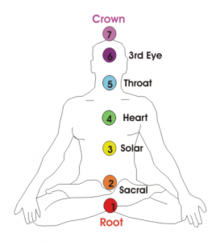
The seven Chakras are arranged along the spinal cord, from bottom to top: 1. Muladhara 2. Svadhisthana 3. Nabhi-Manipura 4. Anahata 5. Vishuddhi 6. Ajna 7. Sahasrara.
The vital chakras ar expressed in Buddhist and Hindu texts to be organized in a very column on the medulla spinalis, from its base to the highest of the pinnacle, connected by vertical channels. The Tantric traditions wanted to master them, awaken and energize them through varied respiratory exercises or with help of a coach. These chakras were additionally symbolically mapped to specific human physiological capability, seed syllables (bija), sounds, refined parts (tanmatra), in some cases deities, colours and different motifs.
The chakra theories of Buddhism and Hinduism differs from the historic Chinese system of meridians in treatment. in contrast to the latter, the chakra relates to refined body, whereby it's a footing however no definite nervous node or precise physical association. The Tantric systems envision it as a regularly gift, extremely relevant and a way to psychic and emotional energy. it's helpful in a very kind of Hindooism rituals and musing discovery of effulgent inner energy (prana flows) and mind-body connections. The meditation is power-assisted by intensive symbology, mantras, diagrams, models (deity and mandala). The professional income step by step from perceptible models, to more and more abstract models wherever divinity and external pattern ar abandoned, inner self and internal mandalas ar woke up.
These concepts don't seem to be distinctive to Buddhist and Hindu traditions. Similar and overlapping ideas emerged in different cultures within the East and also the West, and these ar diversely known as by different names like refined body, spirit body, cryptical anatomy, sidereal body and etheric body. in line with Geoffrey Samuel and Jay full general, professors of spiritual studies legendary for his or her studies on Yoga and cryptical traditions:
Ideas and practices involving supposed 'subtle bodies' have existed several|for several} centuries in many components of the planet. (...) just about all human cultures legendary to North American country have some quite thought of mind, spirit or soul as distinct from the bod, if solely to clarify experiences like sleep and dreaming. (...) a vital set of subtle-body practices, found significantly in Indian and Tibetan Tantric traditions, and in similar Chinese practices, involves the concept of an interior 'subtle physiology' of the body (or rather of the body-mind complex) created from channels through that substances of some kind flow, and points of intersection at that these channels close. within the Indian tradition the channels ar referred to as nadi and also the points of intersection as cakra.
— Geoffrey Samuel and Jay full general, faith and also the refined Body in Asia and also the West: Between Mind and Body
Contrast with classical yoga
Chakra and connected theories are vital to the cryptical traditions, however they're circuitously associated with thought yoga. in line with Edwin Bryant and different students, the goals of classical yoga like religious liberation (freedom, discernment, moksha) is "attained entirely otherwise in classical yoga, and also the cakra / nadi / kundalini physiology is totally peripheral thereto.
CLASSICAL TRADITIONS
.jpg)
Chakras (as well as Yantras and Mandalas) are visualised as lotus with different number of petals representing each chakra.
The classical jap traditions, significantly those who developed in Bharat throughout the first millennium AD, primarily describe nadi and cakra in an exceedingly "subtle body" context.[38] To them, they're the parallel dimension of psyche-mind reality that's invisible however real. within the nadi and cakra flow the prana (breath, life energy).[38][39] The thought of "life energy" varies between the texts, starting from straightforward inhalation-exhalation to way more complicated association with breath-mind-emotions-sexual energy.[38] This essence is what vanishes once an individual dies, going a gross body. Some of it, states this refined body theory, is what withdraws at intervals once one sleeps. All of it's believed to be accessible, awake-able and vital for a personality's body-mind health, and the way one relates to others in one's life.[38] This refined body network of nadi and chakra is, in keeping with some later Indian theories and lots of new age speculations, closely related to emotions.[38][40]
Hindu Tantra Edit
Main article: Kundalini energy
Different mystical traditions in Hinduism mention various numbers and arrangements chakras, of that a classical system of seven is most current.[2][3][4] This seven-part system, central to the core texts of yoga, is one of several systems found in Hindu Buddhism literature. These texts teach many various Chakra theories.[41]
The Chakra methodology is extensively developed within the deity tradition of Hinduism known as Shaktism. it's a vital thought together with yantras, mandalas and kundalini yoga in its observe. Chakra in Shakta tantrism suggests that circle, a "energy center" at intervals, in addition as being a term of cluster rituals like in chakra-puja (worship at intervals a circle) which can or might not involve tantra observe.[42] The cakra-based system is one a part of the brooding exercises that came to be referred to as laya yoga.[43]
Beyond its original Shakta environment, numerous sub-traditions at intervals the Shaiva and Hindoo faculties of Hinduism conjointly developed texts and practices on Nadi and Chakra systems. sure trendy Hindu teams conjointly utilize a way of circular energy work supported the chakras referred to as kriya yoga. Followers of this observe embody the province faculty of Yoga and Self Realization Fellowship, and practitioners ar referred to as kriyaban. though Paramahansa Yogananda claimed this was identical technique instructed as kriya yoga by Patañjali within the Yoga Sūtras and by Krishna within the Bhagavad religious text (as destiny yoga), Hindu Satyananda of the province faculty disagreed with this assessment and acknowledged the similarities between kriya and taoist inner orbit practices. each faculties claim the technique is instructed in all ages by associate degree avatar of god referred to as Babaji. The historicity of its techniques in Bharat before the first twentieth century aren't well established. It believed by its practitioners to activate the chakras and stimulate quicker non secular development.
TYPES OF CHACKRA
1)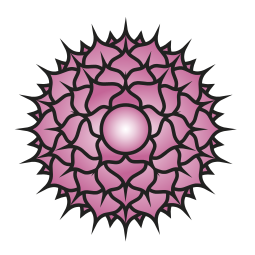 Sahasrara (Sanskrit: सहस्रार, IAST: Sahasrāra, English: "thousand-petaled") or crown chakra is that the upmost chakra within the refined body, set within the crown of the pinnacle. In deep Hinduism and New Age western systems, it's typically thought of to be the best non secular center and therefore the state of pure consciousness, among that there's neither object nor subject. once the female Kundalini Hindu deity rises to the present purpose, it unites with the masculine Shiva, the yogi or yogini achieves self-realisation and a state of liberating samadhi is earned. The chakra is symbolized by a lotus with one thousand multi-coloured petals.
Sahasrara (Sanskrit: सहस्रार, IAST: Sahasrāra, English: "thousand-petaled") or crown chakra is that the upmost chakra within the refined body, set within the crown of the pinnacle. In deep Hinduism and New Age western systems, it's typically thought of to be the best non secular center and therefore the state of pure consciousness, among that there's neither object nor subject. once the female Kundalini Hindu deity rises to the present purpose, it unites with the masculine Shiva, the yogi or yogini achieves self-realisation and a state of liberating samadhi is earned. The chakra is symbolized by a lotus with one thousand multi-coloured petals.
In deep Buddhism, it's known as Mahasukha and is usually thought of to be the flower petal lotus of "Great Bliss" and resembling the fourth state of 4 Noble Truths.
2)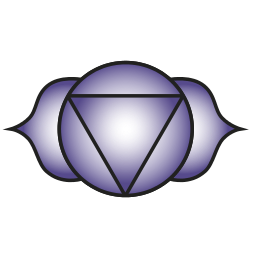
Ajna (Sanskrit: आज्ञा, IAST: Ājñā, English: "command") additionally referred to as guru chakra or third-eye chakra is that the delicate center of energy, believed to be situated between the eyebrows, situated behind it on the delicate (non-physical) vertebral column. it's thus referred to as as a result of this is often the spot wherever the tantra guru touches the seeker throughout the initiation ritual (saktipata). He or she commands the woke up kundalini to withstand this center.
It is symbolised by a lotus with 2 petals.it's at now that the 2 aspect nadi UN agency (yoga) and Pingala square measure aforesaid to terminate and merge with the central channel Sushumna, signifying the top of duality, the characteristic of being twin (e.g. light-weight and dark, or male and female).
3)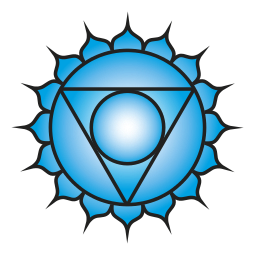
Vishuddha (Sanskrit: विशुद्ध, IAST: Viśuddha, English: "especially pure"), or Vishuddhi, or throat chakra is found at the bottom of refined body's throat. it's symbolized as a sixteen gamopetalous lotus. The Vishuddha is iconographically delineated with sixteen petals lined with the sixteen Indo-Aryan vowels. it's related to the part of house (akasha) and has the seed language unit of the house part Ham at its center. The residing supernatural being is Panchavaktra shiva, with five heads and four arms, and also the Sakti is Shakini.[citation needed]
In mystic Buddhism, it's referred to as Sambhoga and is usually thought-about to be the flower petal lotus of "Enjoyment" and similar to the third state of 4 Noble Truths.
4)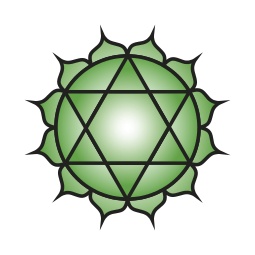
Anahata (Sanskrit: अनाहत, IAST: Anāhata, English: "unstruck") or the guts chakra is found in or behind the guts.
It is symbolised by a lotus with twelve petals.[64] at intervals it's a yantra of 2 intersectant triangles, forming a star, figuration a union of the male and feminine yet as being the private image for the part of air (vayu). The seed mantra of air, Yam, is at its center. The presiding immortal is Ishana Rudra Shiva, and also the Sakti is Kakini.[citation needed]
In private Buddhism, this Chakra is named Dharma and is mostly thought-about to be the floral leaf lotus of "Essential nature" and admire the second state of 4 Noble Truths.
5)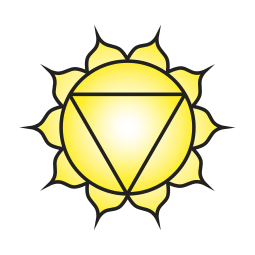
Manipura (Sanskrit: मणिपूर, IAST: Maṇipūra, English: "jewel city") conjointly referred to as the nabhi chakra or the star plexus/navel chakra, is found within the navel region on the refined body's skeletal structure. For the Nath yogi meditation system, this is often delineated because the Madhyama-Shakti or the intermediate stage of discovery.
This chakra is described as AN upward inform triangle representing hearth within the middle of a lotus with 10 petals. The seed language unit for hearth is at its center Ram. The presiding spiritual being is Braddha Hindu deity, with Lakini because the Shakti.
6)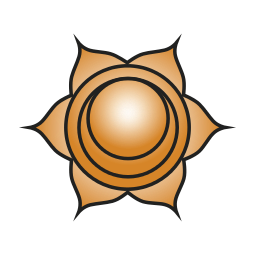
Svadhishthana (Sanskrit: स्वाधिष्ठान, IAST: Svādhiṣṭhāna, English: "the residence of the self") or sacral chakra believed to be situated at the foundation of the sexual organ on the spine within the delicate body.
It is symbolised as a six-petaled lotus. Svadhisthana is drawn with a lotus at intervals that could be a crescent moon symbolising the water part. The seed mantra in its center is Vam representing water. The presiding spiritual being is Brahma, with the Shakti being Rakini (or Chakini).
In cryptic Buddhism, it's referred to as Nirmana and is usually thought-about to be the floral leaf lotus of "Creation" and comparable to the primary state of 4 Noble Truths.
7)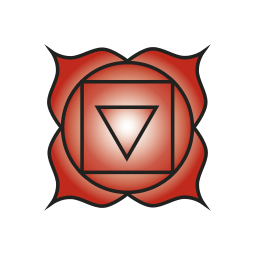
Muladhara (Sanskrit: मूलाधार, IAST: Mūlādhāra, English: "root support") or root chakra placed at the bottom of the spine within the os region of the delicate body. Dormant Kundalini is commonly aforementioned to be resting here, wrapped 3 and a 0.5, or seven or twelve times. generally she is wrapped round the black Svayambhu linga, rock bottom of 3 obstructions to her full rising (also referred to as knots or granthis). it's symbolised as a four-petaled lotus with a yellow sq. at its center representing the component of earth.
The seed language unit is Lam for the world component (pronounced lum),. All sounds, words and mantras within their dormant type rest in the muladhara chakra, wherever Ganapati resides, whereas the Sakti is Dakini. The associated animal is that the elephant.
Other chakras
Many systems include additional chakras including talu bindu manas and dvadashanta chakras.
Reception and similar theories in the West .
In 1918, the interpretation of 2 Indian texts: the Ṣaṭ-Cakra-Nirūpaṇa and therefore the Pādukā-Pañcaka, by Sir John Woodroffe, alias Arthur Avalon, in an exceedingly book titled The Serpent Power introduced the shakta theory of seven main chakras within the West. This book is very careful and complicated, and later the ideas were developed into the predominant Western read of the chakras by C. W. Leadbeater in his book The Chakras. several of the views that directed Leadbeater's understanding of the chakras were influenced by previous believer authors, specifically Johann Georg Gichtel, a fan of Jakob Böhme, and his book Theosophia Practica (1696), within which Gichtel directly refers to inner force centres, an idea appreciate the chakras.
Hesychasm
A completely separate contemplative movement at intervals the jap Eastern Orthodox Church is Hesychasm, a type of Christian meditation. Comparisons are created between the Hesychastic centres of prayer and therefore the position of the chakras. specific stress is placed upon the guts space. However, there's no name these centres as having any style of metaphysical existence. much more than in any of the cases mentioned higher than, the centres ar merely places to focus the concentration throughout prayer.
NEW AGE.
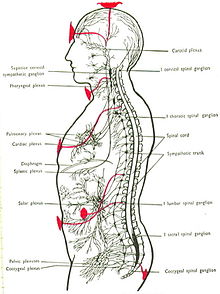 Chakra positions in relation to nervous plexi, from a 1927 textbook
Chakra positions in relation to nervous plexi, from a 1927 textbook
In Anatomy of the Spirit (1996), Carlovingian Myss describes the operate of chakras as follows: "Every thought and skill you have ever had in your life gets filtered through these chakra databases. every event is recorded into your cells...".[72] The chakras area unit delineated as being aligned in associate ascending column from the bottom of the spine to the highest of the top. New Age practices usually associate every chakra with an explicit color. In numerous traditions, chakras area unit related to multiple physiological functions, a side of consciousness, a classical part, and different distinctive characteristics. they're envisioned as lotuses or flowers with a unique variety of petals in each chakra.
The chakras area unit thought to vitalise the form and to be related to interactions of a physical, emotional and mental nature. they're thought of loci of life energy or prana (which New Age belief equates with Hindu deity, vitality in Chinese, ki in Japanese, koach-ha-guf in Hebrew, bios in Greek, and aether in each Greek and English), that is believed to flow among them on pathways referred to as nadi. The operate of the chakras is to spin and attract this energy to stay the religious, mental, emotional and physical health of the body in balance.[citation needed]
Rudolf Steiner thought of the chakra system to be dynamic and evolving. He prompt that this method has become totally different for contemporary folks than it had been in times of yore which it'll, in turn, be radically totally different in future ti Steiner delineated a sequence of development that begins with the higher chakras and moves down, instead of taking possession the alternative direction. He gave suggestions on a way to develop the chakras through disciplining thoughts, feelings, and will.
According to Florin Lowndes, a "spiritual student" will more develop and deepen or elevate thinking consciousness once taking the step from the "ancient path" of schooling to the "new path" described by Steiner's The Philosophy of Freedom.[note 2]
Endocrine system
Chakras and their importance area unit posited to reside within the psyche. However, there area unit those that believe that chakras have a physical manifestation yet. urban center Osborn, as an example, has delineated the chakras as metaphysical counterparts to the endocrine glands, whereas Anodea Judith noted a marked similarity between the positions of the 2 and also the roles delineated for every. author Sturgess conjointly links the lower six chakras to specific nerve plexuses on the funiculus yet as glands. C.W. Leadbeater associated the Ajna chakra with the pineal secretor, that may be a a part of the system. These associations stay speculative, however, and have nonetheless to be by trial and error valid.
https://steemit.com/onstellar/@onstellar/the-paranormal-onstellar-contest-win-225-steem-for-articles-and-memes